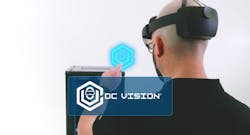The first idea was to offer dedicated technical services for organizations that want to outsource their data center operations. Indeed, we are still convinced in that service offering but quickly realized that there are technologies available to address the most important issues and simplify many operational tasks on a larger scale. Technologies such as AR and Artificial Intelligence (AI) are revolutionizing industry and business world at a breathtaking speed. How could those technologies be combined to optimize efficiency, reduce downtime, and improve performance in data center operations?
Within our intense research, we got fascinated by the Digital Twin concept that now lays ground for our DC Vision software solution. The idea and the term “Digital Twin” originate from the American space agency NASA. They digitally replicated the enormously complex and expensive spacecraft to be able to simulate the behavior of the systems at any time without endangering the physical systems. Applied to the data center world, our first step was to create 3D digital copies of entire racks including all system components. In a next step, we added data from systems such as Data Center Infrastructure Management (DCIM). Today, we are proud to introduce DC Vision, a complete software solution based on the digital twin technology enriched with data from different resources that can easily be integrated via API.
Here is where AR enters the stage: a 3D digital copy of the rack can be overlaid with all data collected from multiple sources. Thanks to AR, information is visualized and presented much more intuitive and engaging than traditional charts and graphs could ever do. Real-time information on performance, energy consumption, and other key metrics completes the picture. Using augmented reality, the data can not only be retrieved, but also updated. For example, without having to enter additional data on a laptop, information in the Data Center Infrastructure Management System (DCIM) can be updated via the integrated gesture and mimic control. Media disruption is avoided and the key information about the system components remains up to date.
As if keeping information up-to-date and simplifying their usage wouldn’t be great news itself, there is much more to it. Having all the data at your fingertip, tools like DC Vision offer new capabilities when combining with artificial intelligence. Take for example the case that there are anomalies on a rack. By using object recognition and AI, the system instantly detects discrepancies, localizes errors and accelerates solving the issue. By the way, this also plays a key role when it comes to optimizing data centers in terms of energy consumption, space capacity and efficiency. The AR visualization of sensor data combined with data from the different components also opens new chances to detect optimization potential.
The benefits of the AR based software solutions are evident in a variety of applications:
- Training and education of new team members become much easier and more efficient with Digital Twin technology. The rack layout and related details can be called up in the DC Vision system at any time. Training sessions do not necessarily have to take place on site in the data center.
- Before maintaining or installing components in the rack, the necessary connections can be checked virtually, and the component set-up can be planned in advance.
- If a company uses the remote hands services of a colocation provider, for example, the company's IT managers can plan and accompany changes or repairs remotely.
- Documentation of the existing IT infrastructure and asset inventory in the DCIM is of critical importance for companies. By simplifying documentation workflows, it is more likely that the documentation is updated on a regular basis and relevant information is immediately available in the event of a fault. Additionally, many certifications require up-to-date asset data. Innovative solutions such as DC Vision ensure that operational processes are permanently secured and "last minute" actions to update data are avoided.
I am sure the future will bring even more fascinating options on what and how to improve data center operations by using innovative technologies such as augmented reality. Together, we are exploring every day use cases through our collaboration with the GSI Helmholtzzentrum für Schwerionenforschung in Darmstadt, partners, and customers. Just follow me on LinkedIn to find out more.
Jörg Hesselink is CEO and Founder of DC Smarter, a brand of managed service provider FacIT FixIT GmbH. The company's DC Vision software is based on the concept of the digital twin and uses augmented reality glasses, smartphones, or tablets to optimize the maintenance and care of the IT infrastructure in data centers. For more information, see https://dc-smarter.com/ or follow us on LinkedIn.



